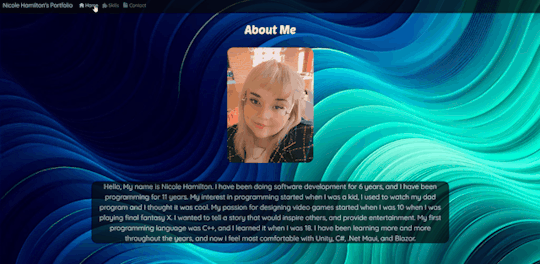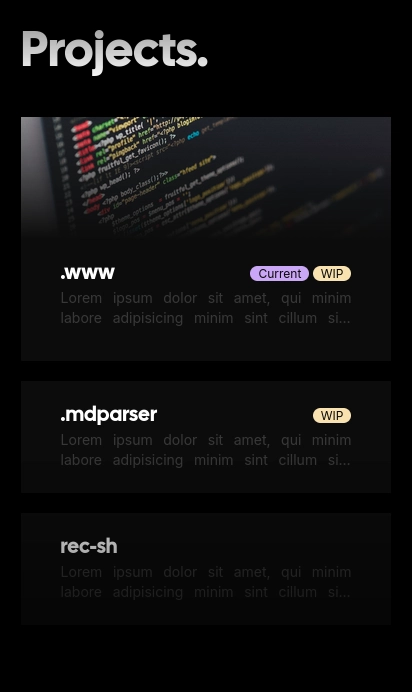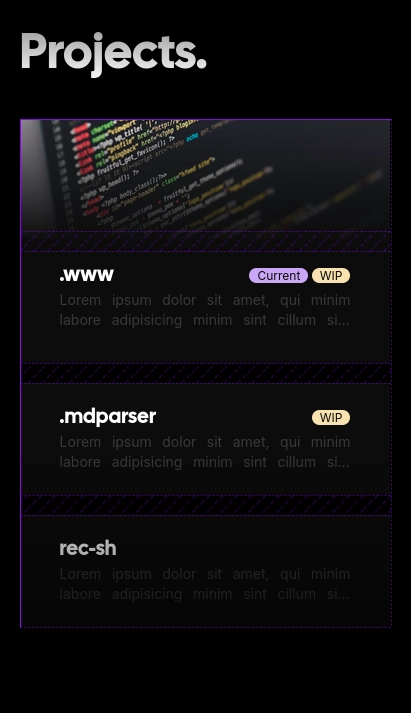#css3 developer
Explore tagged Tumblr posts
Text
1 note
·
View note
Text
i find it annoying when on google i search something like "how to make an artsy personal website" and lots of the results will be like "use wordpress" or "make sure it's good for search engines", like shut your fuckin' mouth, i wasn't lookin' for that, i was trying to figure out how to build and design a website that isn't boring looking. literally every html/css tutorial i've been on has taught me how to make your basic website but not how to make it look less boring. i wanna have stuff like the snazzy websites people have trending on neocities plus more accessibility but i can't figure out how to do that with the knowledge i have currently.
#fuck google#why can't i just find the answers i want#web design#web development#html css#html#css#html5 css3#html5#css3#front end development#front end web development#mine#seeking advice#tw cursing
16 notes
·
View notes
Text

Bootstrap Web Layout
#bootstrap web layout#responsive web design#bootstrap snippets#html css#divinector#css#html#webdesign#css3#divinectorweb#web design#web development
3 notes
·
View notes
Text
Why won't my CSS style work?
Ever had that frustrating experience where your carefully crafted styles refuse to do their thing? Well, today, I am going to demystify CSS selector priority for you.
CSS selector priority
CSS selector priority determines which styles take precedence when multiple rules target the same element. It's crucial to grasp this concept to avoid unexpected styling conflicts in your web projects. There are several factors that influence selector priority, and understanding them will help you control the appearance of your web page elements effectively.
1. Specificity
Specificity is a measure of how specific a CSS selector is in targeting an element. It's often denoted as a four-part value, such as 0,0,0,0, where each part represents a different level of specificity for the selector. The more specific a selector is, the higher its priority. For example:
Inline styles have the highest specificity.
ID selectors (#element-id) are more specific than class selectors (.element-class).
Elements selectors (div, p, etc.) have the lowest specificity.
2. Importance
CSS properties marked with !important have the highest priority, even if other rules have greater specificity. However, it's generally recommended to use !important sparingly to avoid confusion and maintain a clean codebase.
3. Source Order
When all else is equal, the source order of CSS rules in your stylesheet determines which one takes precedence. The rule that appears last in the stylesheet will override previous rules targeting the same element.
Resolving CSS Priority Issues
Now let's explore how to resolve priority conflicts
1. Use Specific Selectors
To increase the specificity of your selectors, consider using more specific class or ID names. This will make your rules override less specific ones and help you maintain better control over your styles.
2. Avoid Using !important
While !important can be helpful in certain situations, it's generally best to avoid it whenever possible. Overusing !important can make your CSS harder to maintain and debug.
3. Review Source Order
If you're still facing priority issues, review the order in which your CSS rules are defined in your stylesheet. Ensure that the rule you want to take precedence appears after conflicting rules.
By following best practices and avoiding overuse of !important, you'll create more maintainable and predictable CSS code. So, the next time you wonder, "Why does my CSS priority not apply to my element?", remember what we talked about in this post.
Happy coding!
#html css#css#html5 css3#css3#code#codeblr#html#javascript#java development company#python#studyblr#progblr#programming#comp sci#web design#web developers#web development#website design#webdev#website#tech#learn to code
57 notes
·
View notes
Text

✧ PSD to HTML Magic ✧
Your stunning designs deserve flawless code ✨
At Xhtmlchop, we transform your PSDs into: ☑️ Pixel-perfect HTML/CSS ☑️ Buttery-smooth responsive layouts ☑️ Lightning-fast load speeds ☑️ SEO-friendly markup that ranks
🔥 Deal Alert: Homepage conversion → 199
Additional pages → 129 each
We include: ✓ 100% hand-coded solutions ✓ Cross-browser perfection ✓ Optional NDA protection ✓ Money-back guarantee
Let’s collaborate! → https://www.xhtmlchop.com/psd-to-responsive.html
(Reblog if you’ve been looking for PSD conversion services!)
#WebAlchemy#PSDtoHTML#CodeWizards#FrontEndDev#DigitalTransformation#webdesign#webdevelopment#figma to html#web graphics#website#psd to html#htmlcoding#html5#html css#javascript#css#html5 css3#web development
3 notes
·
View notes
Text
Fellow programmers:
#full stack developer#code#codeblr#studyblr#study motivation#motivation#tumblr polls#my polls#my post#developer#front end development#software development#software#backenddevelopment#frontend developer#html5 css3#backend frameworks#frontenddevelopment#html css
10 notes
·
View notes
Text
I've found someone you should follow on Pinterest!
I thought you'd like the ideas this person's been saving on Pinterest... https://pin.it/4ZUJ4bryL
https://pin.it/4ZUJ4bryL
Follow me on Pinterest 😉
#pinterest#html#css3#tamilitmemes#tamilwebdesign#css animation#web design#web development#website#webdesign#youtube#web developer#website development#development#developer#responsive webdesign#responsivewebdesign#responsive design#responsive web design#it memes#office memes#memelife#memes#funny memes#programmers#programminglanguage#programmer#program#work in progress#affiliate program
10 notes
·
View notes
Text

Days 128 to 129
I have worked hard on my portfolio site and added some cool animations and tool tips. I have done lots of prettying up as well. Tomorrow I'll fully implement the contact page.
#self improvement#cosmickittytalk#codeblr#csharp programming#csharp#csharp is superior#girls who code#programming#coding challenge#blazor#blazor programming#blazor website development#javascript#html css#html5 css3#htmlcoding#html5#css3#css animation examples#css#web development#website#front end development#full stack developer#coding for a year#coding#website development#website design#website animation#animated website
13 notes
·
View notes
Text
The plan: Introductory Post
Hello everyone!
I'm mostly writing this post to pin it to my blog page for those who visit.
The heart of this blog is tracking a website I will build from the ground up. This includes the front-end, back-end, UX/UI design, and any other planning/work that pops up.
For some context, around a year ago, I started practicing web development to make it my career. However, things turned out differently than expected. I got another job after having horrendous luck finding work. I really enjoy it, so it snuffed out my drive to find a career in web development.
However, I've always liked web development and programming in general. I've always wanted to use it, but I just didn't have any ideas I wanted to commit to. Now, I have a site that I feel I can turn into a full-fledged application, and I'd like to track it here for those interested and connect with others interested.
I've been on a six-month hiatus, so I'm pretty rusty, but I've decided I want to build the site using Svelte and Supabase. Svelte has always been the framework I wanted to learn, so this website is the perfect excuse. I also have experience with Firebase, but I wanted to challenge myself by learning Supabase. Most of my experience is with React and Next.js. I've used them for volunteer work and for freelancing gigs in the past.
I'll also give a brief summary of my website for common understanding. The MVP will start as a blog, but I plan to expand it to turn it into an informative database (sort of like Wikipedia) and have some interactive elements. I won't get into the meat of the idea, but that's what to expect with my posts. But before that, my posts will mostly be centered around a summary of my learning. Since I'm learning Svelte, my current posts will be based on that.
Thanks for stopping by, and I look forward to hearing your comments or insights moving forward! If you have any questions, feel free to ask!
#programming#coding#developer#web development#tech#website#web design#website development#ui ux design#svelte#supabase#technology#learning#growth#work#organization#habits#time management#potential#connection#framework#javascript#typescript#html#htmlcoding#html5#html css#css#css3#html5 css3
3 notes
·
View notes
Text
current version
the current version of the generatr theme (0.0.0a) supports as of right now:
text (duh)
images and GIFs
link posts
audio/video posts
for 0.0.1a i plan to add more user-friendly customization of color palettes (which may include completely rewriting the theme), and added support for more tumblr features.
more to come. downloads for the current version will be available soon.
notes are not yet supported but should be soon, hopefully by 0.0.5a. dates of posts as well.
#programming#coding#html css#css3#retro#livejournal#blog theme#old web#early internet#2000s nostalgia#early 2000s#2000s aesthetic#00s#aughts#blog#blogging#web development#computer#old tech#aesthetic#technology#journaling#digital diary#software development#internet#weblog#retro aesthetic#techcore
2 notes
·
View notes
Text
Making a Website: A Beginner’s Guide
Creating a website is one of the most powerful ways to build an online presence. Whether you want to promote your brand, grow your business, or share your personal blog, making a website can make a significant impact. Here’s a beginner’s guide to help you navigate the essential steps and make the process smoother.
1. Define the Purpose of Your Website
Before you start, it’s crucial to clearly define the purpose of your website. Are you building an e-commerce store, a blog, or a portfolio site? Understanding your goals will help guide your design choices, content strategy, and the overall structure of your website. Knowing the purpose is essential to making a website that resonates with your audience.
2. Choose the Right Platform
Selecting the right website platform is key to achieving a user-friendly and professional website. Platforms like WordPress, Wix, and Squarespace offer various templates and customization options, but if you want full control, consider creating a custom website. For more insights on choosing a platform, check out Making a Website.
3. Prioritize User Experience and Design
A well-designed website should be easy to navigate and visually appealing. Make sure to create a layout that guides visitors smoothly through your content. Focus on mobile responsiveness, intuitive menus, and fast loading speeds to keep users engaged. Making a website that prioritizes the user experience can lead to higher visitor satisfaction.
4. Optimize for SEO
To increase visibility, ensure your website is SEO-friendly from the start. Use relevant keywords, optimize image sizes, and write clear meta descriptions. By paying attention to these SEO basics, you can help your website rank better on search engines, attracting more visitors. These steps are crucial in making a website that stands out.
Creating a website is a journey that can transform your online presence. Remember, the key to success lies in setting clear goals, selecting the right tools, and prioritizing the user experience. For more tips on building and optimizing your website, don’t forget to explore the resources available at Making a Website.
2 notes
·
View notes
Text
Container Queries
Day 214 - Jun 6th, 12.024
Today is a small post, finally was able to get some work done on the day. Something, which I learned while making the projects section on my website, is the CSS feature called container queries. In summary, it is similar to the media queries, but based on the size of the parent element/container, so you can apply styles based on the element size, not just the viewport. It is somewhat powerful I would say, since nowadays, where we try to isolate HTML into components, most of the time the components don't have the context of the parent element or how it will be used. Somewhere I find it useful is in card-like components, which you can't just limit the size, since they can be placed on any context and grids. Using container queries, you can make the card itself adapt to where it is.
An example, and where I used it today, is this small grid where I wanted the first card to be always bigger. The first element always occupies two rows. And the card itself adapts and shows its banner since there's enough space for it.


Today's artists & creative things Album: Magnifique - by ratatat
© 2024 Gustavo "Guz" L. de Mello. Licensed under CC BY-SA 4.0
3 notes
·
View notes
Text
React JS
Component-Based Architecture:
React applications are built using components, which are reusable, self-contained pieces of the UI. Components can be nested, managed, and handled independently, leading to better maintainability and scalability.
JSX (JavaScript XML):
React uses JSX, a syntax extension that allows HTML to be written within JavaScript. This makes the code more readable and easier to write.
Virtual DOM:
React maintains a virtual DOM, an in-memory representation of the actual DOM. When the state of an object changes, React updates the virtual DOM and efficiently determines the minimal set of changes needed to update the real DOM, leading to performance improvements.
One-Way Data Binding:
Data flows in one direction, from parent to child components, which makes the data flow and logic easier to understand and debug.
State Management:
React components can maintain internal state, making it easy to build dynamic and interactive UIs. For more complex state management, libraries like Redux or Context API can be used.
Advantages of Using React
Performance:
Due to the virtual DOM, React minimizes direct manipulation of the DOM, resulting in better performance for dynamic applications.
Reusable Components:
Components can be reused across different parts of an application, reducing the amount of code and enhancing consistency.
Strong Community and Ecosystem:
A large community and a rich ecosystem of tools and libraries support React, making it easier to find solutions, get support, and integrate with other technologies.
SEO Friendly:
React can be rendered on the server using Node.js, making web pages more SEO-friendly compared to traditional client-side rendering.
Getting Started with React
To start building applications with React, you need to have Node.js and npm (Node Package Manager) installed. Here’s a basic setup to create a new React application:
Install Node.js and npm:
Download and install from Node.js website.
Create a New React Application:
You can use Create React App, an officially supported way to create single-page React applications with no configuration required:
npx create-react-app my-app cd my-app npm start
import React from 'react';
function Welcome(props) { return
Hello, {props.name}
; }
export default Welcome;
#React JS#Front end Developer#Advanced JavaScript#coding#html css#htmlcoding#html#css#php#website#html5 css3#software#React Training
5 notes
·
View notes
Text

3D Responsive Image Gallery
#3d responsive image gallery#responsive web design#html css#divinector#webdesign#css3#css#frontenddevelopment#html#responsive web development#image gallery html css#flip card animation#css animation#learn to code
4 notes
·
View notes
Text
Myshop3d.fr
Bonjour ! voici mon site web : myshop3d.fr
2 notes
·
View notes